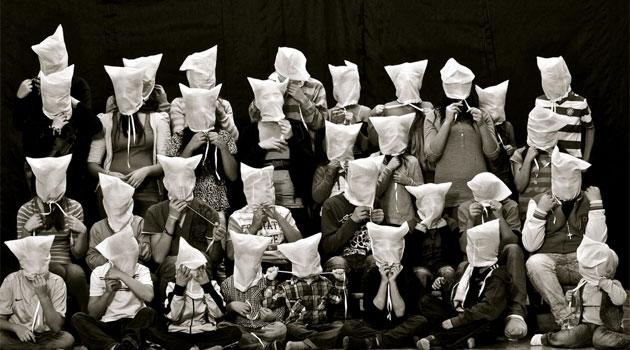In an historical first, Romani artist Małgorzata Mirga-Tas represents Poland at the Venice Biennale with “Re-enchanting the World”

History has been made at the Venice Biennale this year. For the first time in 127 years of this arts festival, which takes place every other year, an artist of Romani origin is representing a European state.
Małgorzata Mirga-Tas, a Polish artist of Romani origin, decorated the Polish pavilion for this occasion with her images of monumental size made from fabric patchwork. “For us, the curators of the exhibition, it is a great privilege that this is not just a Polish pavilion and Polish art, but that it is a trans-European and transnational pavilion. The artist offers a new European concept, because Romani people and Romani culture live all across Europe. Thanks to the fact that we have this common culture in Europe, we can go beyond our national boundaries,” said curator Joanna Warsza in an interview for Romea.cz.
The exhibition is called “Re-enchanting The World”. This means “to charm the world, to change it with new magic” and metaphorically “to change deeply-rooted prejudices and stereotypical thinking”.
A book of the same name by Silvia Federici inspired the exhibition title; Federici’s subject is that of non-violent processes stemming from the actions of ordinary people and from feminism, actions that “break curses” and restore human relationships. Feminism, the theme of this year’s 59th Biennale, is also reflected in these collages of textiles in the Polish pavilion.

Małgorzata believes it is mainly women who have the ability to change the world. Her “goddesses” are captured in the central, horizontal part of each of 12 panels.
The artwork depicts both women who are publicly known and those whose heroism has remained secret. “I combined portraits of these real women with symbols from astrology and tarot cards, which greatly increases their power and strength to transform the world through their magic,” Małgorzata Mirga-Tas, nicknamed “Gosia”, said in an interview for the Roma MoMA blog of the European Roma Institute of Arts and Culture (ERIAC).
Gosia was entrusted with the Biennale presentation after winning the competition held by the Polish National Art Gallery. She graduated in sculpture from the Academy of Arts in Cracow and began experimenting with patchwork using textiles 16 years ago, while pregnant with her first son.
Looking out at us from her huge canvases are the artist’s own grandmother Jozefa, her own mother, and the well-known Polish Romani woman Alfreda Markowska, who saved 50 children of Jewish and of Romani origin from being transported to the Nazi concentration camps. Markowska concealed the children under her long, wide skirt and led them out of a train station secretly, then hid them in her own home and took care of them.
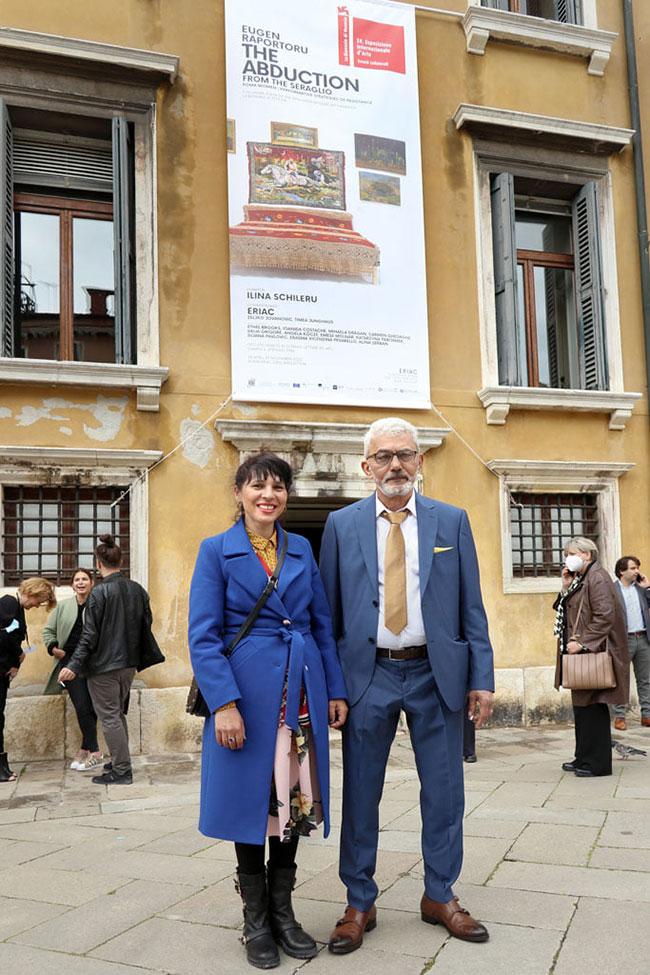
The panels symbolize the 12 months of the year, but Gosia needed more room to capture all of the women who have inspired her, and therefore she intends to expand her current project further. Among her future goddesses will be the Czech Romani woman Jana Horváthová, director of the Museum of Roma Culture in Brno, Czech Republic.
The exhibition is Gosia’s own interpretation of the Renaissance-era frescoes located in the Salon of the Months at the Schifanoia Palace in Ferrara in northern Italy. There, however, instead of goddesses who are Romani, the gods of Olympus rule the individual months.
Following the example of the Salon of the Months at Schifanoia, the artist divided her canvases into three horizontal parts. In addition to the aforementioned central parts, the upper parts feature scenes from the arrival of the Roma in Europe, while the lower sections feature images of what life is like for Romani people today in the part of Poland where the artist lives.
These fabric images on the walls of the Polish pavilion are a riot of colors and of seemingly disparate patterns, creating a comprehensive image through their detail and diversity, one in which both animals and human beings come alive. The artist frequently uses the clothing of the very models captured in the pictures to create their images which, according to her, imprints the figures with their own spirits.
The extensive patchwork was sewn in the Hotel Imperial near the artist’s “own” small town of Czarna Góra in the Tatras, on the border between Poland and Slovakia. The Hotel Imperial, which was about to be reconstructed, gave her all their old covers and curtains.
The artworks themselves are a kind of documentation, historically speaking, of the lives of Romani people. Through their authenticity and beauty they combat the centuries of prejudice and stigma that the Roma have had to face.
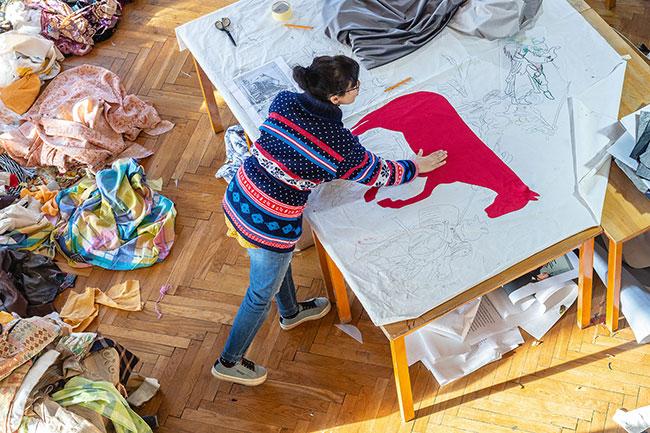

“I wanted to tell my own story, the story of myself, my family and my community,” Gosia told Romea.cz. “It’s just a small drop so far, but I believe we’ll see more and more such things. As a Romani woman, I feel this is an important moment for our Romani community, for Europe and for the world. I hope it is the beginning of other Romani artists representing other countries.”
“This isn’t just an exhibition for the Polish pavilion, but for all Europeans, because we Roma live in all countries. I’m from Poland, but when I meet Roma from other countries, I feel we’re one big family. We support each other. I can feel how much everybody supports me,” the artist told Romea.cz.
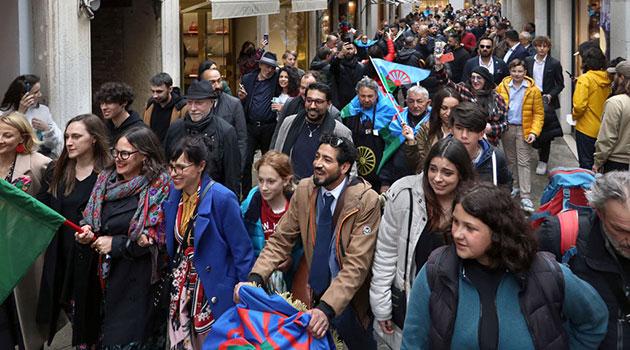
During the grand opening of the exhibition on 22 April at the Polish pavilion in the Venetian Gardens, where the pavilions of other countries can also be found, crowds of journalists and of activists from the Romani community were flowing through the space. One of them is Ervin Bajram, an activist from an Italian organization working against the discrimination of the Roma called Kethane, who says that he and other Romani people are proud of the exhibition.
Bajram also says the Roma are one big family. “When we meet, it doesn’t matter where we’re from, we understand each other in the same way,” he says.
The activist said he likes the artworks’ color scheme, their detailed depictions of animals and human beings, and their magnificence. “All prejudices are broken down here,” he adds enthusiastically.
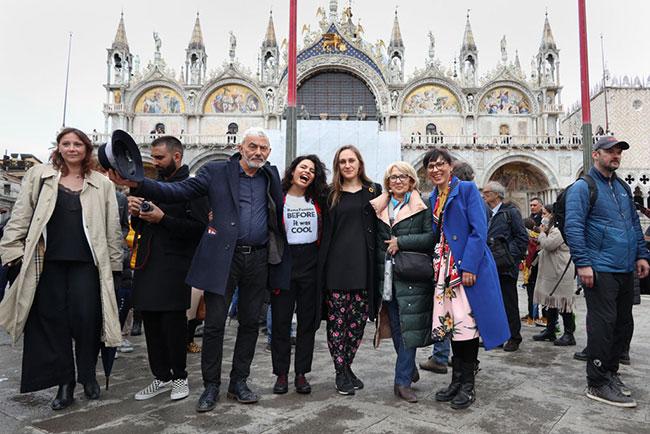
The exhibition is gradually being seen by tourists from all over the world. Cleo and Mari, young women from France, express their feelings about it as follows: “Excellent, Poland!”
“Even in France, Romani culture is not celebrated and we would welcome something like that,” the young women say. Another young woman from Hungary, Viola Lukács, adds her opinion: “This is bold and important, especially because Eastern Europe has a history of persecuting the Roma. It is important that the minorities are visible.”
During the grand opening, music by “The Pillers”, a Romani duo, echoes through the hall. When, during her speech, Gosia wants to draw attention to the portrait of her grandmother and mother, her voice catches with emotion.
“This exhibition is quite important to my family. I think it is giving them a great deal of strength,” the artist confides later.
Perhaps the important message of the exhibition is best summarized by Gilda Horvát, an activist and journalist of Romani origin living in Vienna, Austria. “History is being written here. This is magic. Look with your heart to understand it,” she says.
